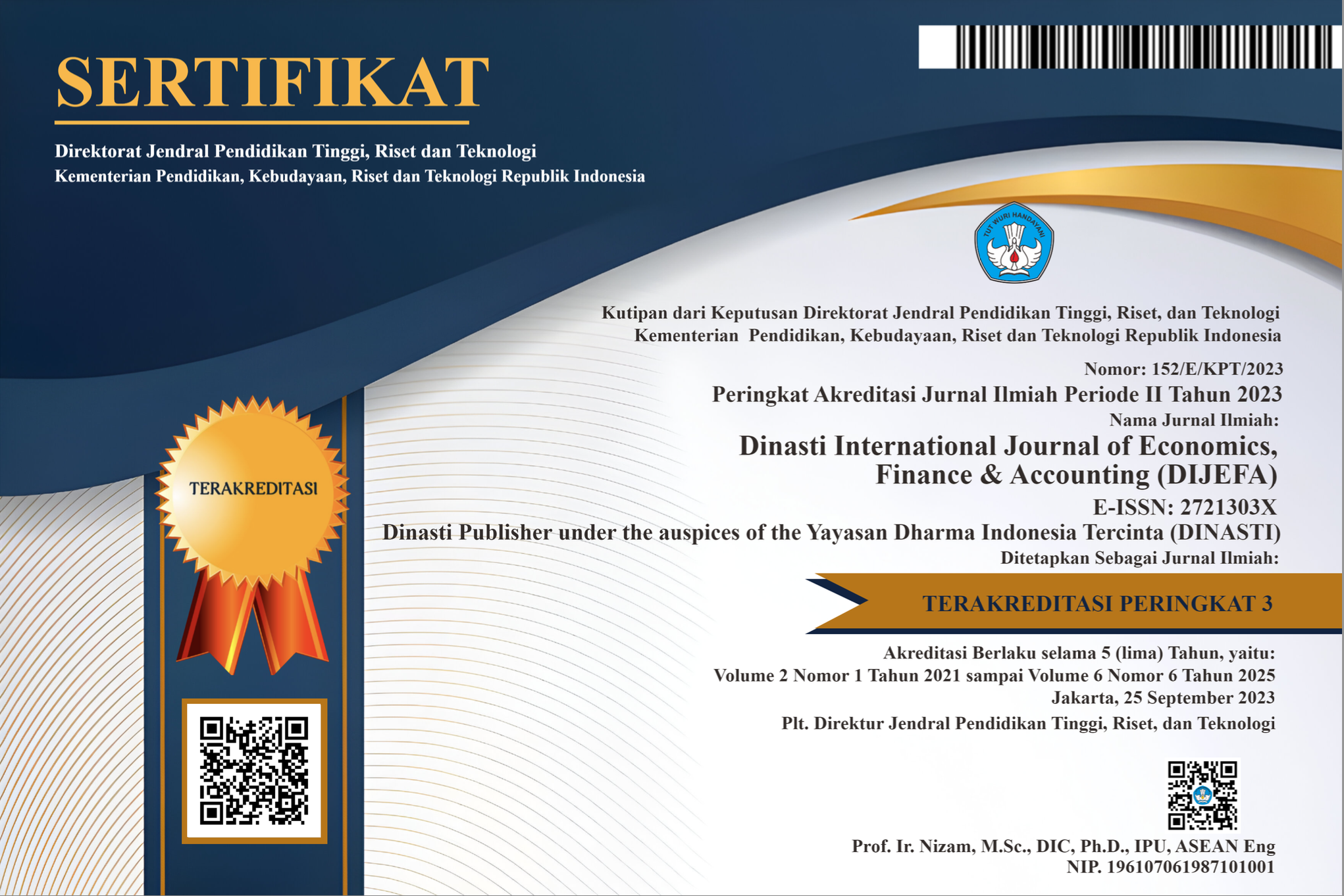Factors that Influence the Decision to Choose Consumer Credit at PT BPR Baturaja (Perseroda) With Age as a Moderating Variable
DOI:
https://doi.org/10.38035/dijefa.v5i3.2792Keywords:
Consumer Credit, Service Quality, Promotion, Interest Rate, Age VariableAbstract
As individuals age, they typically acquire more financial obligations, such as funding their children's education or planning for retirement, which can impact their decision to utilize consumer credit. This study aims to investigate the factors influencing the decision to opt for consumer credit at PT BPR Baturaja (Perseroda), with age serving as a moderating variable. The research methodology employed is associative descriptive research. The sampling technique utilized is probability random sampling, determined by the Slovin formula, resulting in a total sample size of 322. Data analysis was conducted using the Partial Least Square (PLS) method. The research findings lead to several conclusions: Firstly, service quality exerts a positive and significant influence on the decision to choose consumer credit at PT BPR Baturaja (Perseroda). Secondly, promotion demonstrates a positive but statistically insignificant effect on the decision to choose consumer credit at PT BPR Baturaja (Perseroda). Lastly, the interest rate has a positive and significant impact on the decision to select consumer credit at PT BPR Baturaja (Perseroda). The age variable acts as a Quasi Moderator (Quasi Moderation) on the influence of service quality on the decision to choose consumer credit at PT BPR Baturaja (Perseroda). The age variable acts as a Moderation Predictor on the influence of promotions on the decision to choose consumer credit at PT BPR Baturaja (Perseroda). The age variable acts as a Pure Moderator on the influence of interest rates on the decision to choose PT BPR Baturaja (Perseroda) consumer credit.
References
Abadi, J., Brunnermeier, M., & Koby, Y. (2023). The reversal interest rate. American Economic Review, 113(8), 2084–2120.
Abaidoo, R., & Agyapong, E. K. (2023). Inflation uncertainty, macroeconomic instability and the efficiency of financial institutions. Journal of Economics and Development, 25(2), 134–152.
Adesti, B. A., & Aravik, H. (2023). Analisis Faktor-Faktor Yang Memengaruhi Perilaku Konsumen Dalam Menggunakan Jasa Leasing Dalam Perspektif Ekonomi Islam Pada PT. FIF Group Cabang Bukit Palembang. Jurnal Bisnis Dan Manajemen (JURBISMAN), 1(1), 37–62.
Afthanorhan, A., Awang, Z., Rashid, N., Foziah, H., & Ghazali, P. (2019). Assessing the effects of service quality on customer satisfaction. Management Science Letters, 9(1), 13–24.
Agarwal, S., Pan, J., & Qian, W. (2020). Age of decision: Pension savings withdrawal and consumption and debt response. Management Science, 66(1), 43–69.
Agarwal, S., Qian, W., Seru, A., & Zhang, J. (2020). Disguised corruption: Evidence from consumer credit in China. Journal of Financial Economics, 137(2), 430–450.
Agatha, R. C., & Priana, W. (2020). Analisis Pengaruh Capital Adequacy Ratio (CAR), Non Performing Loan (NPL), Loan To Deposit Ratio (LDR), Dan Suku Bunga Kredit Konsumsi Terhadap Penyaluran Kredit Pemilikan Rumah (KPR) Bank BTN. OECONOMICUS Journal of Economics, 4(2), 89–103.
Aguirre, A. (2020). The Credit Promotion to the Business Groups in Chilean Import Substitution Industrialization (1939-1970). América Latina En La Historia Económica, 27(3).
Alper, E., Clements, B., Hobdari, N., & Moya Porcel, R. (2020). Do interest rate controls work? Evidence from Kenya. Review of Development Economics, 24(3), 910–926.
Alzoubi, H. M., Vij, M., Vij, A., & Hanaysha, J. R. (2021). What leads guests to satisfaction and loyalty in UAE five-star hotels? AHP analysis to service quality dimensions. Enlightening Tourism. A Pathmaking Journal, 11(1), 102–135.
Amelia, V. H. I. (2021). Faktor-Faktor Yang Mempengaruhi Penggunaan Fitur Spaylater Pada Aplikasi Shopee Dan Pengaruhnya Terhadap Perilaku Konsumtif.
Amirullah, M., & Devi, A. (2020). Analisis Respon Kredit Dan Pembiayaan Industri Perbankan Di Indonesia. MALIA: Journal of Islamic Banking and Finance, 4(2), 105–117.
Anggraeni, T. R. W. (2023). Analisis Faktor-Faktor Yang Mempengaruhi Keputusan Konsumen Dalam Mengambil FIF group Cabang Surabaya. Jurnal Ilmu Administrasi Bisnis, 12(1), 410–417.
Anton, M. (2016). Manajemen Perbankan. CV Pustaka Setia.
Apriliyani, E., & Taufiq, M. (2022). Analisis Pengaruh Penyaluran Kredit Produktif Dan Kredit Non Produktif Terhadap Pertumbuhan Ekonomi Indonesia. ULIL ALBAB: Jurnal Ilmiah Multidisiplin, 1(6), 1542–1552.
Argyle, B., Nadauld, T., & Palmer, C. (2023). Real effects of search frictions in consumer credit markets. The Review of Financial Studies, 36(7), 2685–2720.
Arianti, R. N., & Abdullah, M. F. (2021). Analisis Pengaruh Suku Bunga, Inflasi dan Pdb Terhadap Jumlah Permintaan Kredit Perbankan di Indonesia Tahun 2009-2019. Jurnal Ilmu Ekonomi, 5(1), 103–117.
Arifudin, O., Sofyan, Y., Tanjung, R., & Rusmana, F. D. (2021). Pengaruh Kelas Sosial, Pengalaman dan Gaya Hidup terhadap Perilaku Penggunaan Kartu Kredit. Jurnal Ilmiah Manajemen, Ekonomi, & Akuntansi (MEA), 5(1), 286–298.
Asyahri, Y. (2022). Korelasi Promosi Terhadap Keputusan Nasabah dalam Memilih Pembiayaan Kredit Perumahan Rakyat (KPR) Bersubsidi. Qonun Iqtishad EL Madani Journal, 1(2).
Battiston, S., Dafermos, Y., & Monasterolo, I. (2021). Climate risks and financial stability. In Journal of Financial Stability (Vol. 54, p. 100867). Elsevier.
Baziki, S., K?l?ç, Y., & Yilmaz, M. H. (2020). Consumer Loan Rate Dispersion and the Role of Competition: Evidence from the Turkish Banking Sector. Available at SSRN 3756276.
Boonlertvanich, K. (2019). Service quality, satisfaction, trust, and loyalty: the moderating role of main-bank and wealth status. International Journal of Bank Marketing, 37(1), 278–302.
Brigham, E F, Ehrhardt, M. C., & Fox, R. (2019). Financial Management: Theory and Practice. Cengage Learning. https://books.google.co.id/books?id=aofxvQEACAAJ
Brigham, Eugene F., & Weston, J. F. (2012). Dasar-dasar Manajemen Keuangan. Salemba Empat.
Brychko, M., Bilan, Y., Lyeonov, S., & Mentel, G. (2021). Trust crisis in the financial sector and macroeconomic stability: A structural equation modelling approach. Economic Research-Ekonomska Istraživanja, 34(1), 828–855.
Budianto, E. W. H. (2023). Pemetaan Penelitian Seputar Risiko Kredit pada Perbankan Syariah dan Konvensional: Studi Bibliometrik VOSviewer dan Literature Review. BANCO: Jurnal Manajemen Dan Perbankan Syariah, 5(1), 20–34.
Caksana, R. A., & Wulandari, D. (2021). Faktor yang mempengaruhi keputusan pengambilan kredit konsumtif pada aparatur sipil negara Kecamatan Lumajang. Jurnal Ekonomi, Bisnis Dan Pendidikan (JEBP), 1(9), 889–905.
Chen, Z., Mirza, N., Huang, L., & Umar, M. (2022). Green banking—can financial institutions support green recovery? Economic Analysis and Policy, 75, 389–395.
Choi, Y., Choi, M., Oh, M., & Kim, S. (2020). Service robots in hotels: understanding the service quality perceptions of human-robot interaction. Journal of Hospitality Marketing & Management, 29(6), 613–635.
Correa, E., & Girón, A. (2019). Financial inclusion and financialization: Latin American main trends after the great crisis. Journal of Economic Issues, 53(2), 496–501.
Dam, S. M., & Dam, T. C. (2021). Relationships between service quality, brand image, customer satisfaction, and customer loyalty. The Journal of Asian Finance, Economics and Business, 8(3), 585–593.
Downloads
Published
How to Cite
Issue
Section
License
Copyright (c) 2024 Rahma Delawati, Sulastri, Aslamia Rosa

This work is licensed under a Creative Commons Attribution 4.0 International License.
Authors who publish their manuscripts in this journal agree to the following conditions:
- The copyright on each article belongs to the author(s).
- The author acknowledges that the Dinasti International Journal of Economics, Finance & Accounting (DIJEFA) has the right to be the first to publish with a Creative Commons Attribution 4.0 International license (Attribution 4.0 International (CC BY 4.0).
- Authors can submit articles separately, arrange for the non-exclusive distribution of manuscripts that have been published in this journal into other versions (e.g., sent to the author's institutional repository, publication into books, etc.), by acknowledging that the manuscript has been published for the first time in the Dinasti International Journal of Economics, Finance & Accounting (DIJEFA).


























































